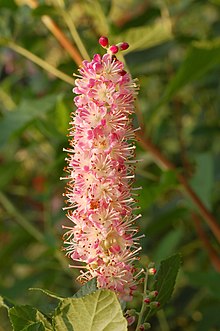| Clethra | |
|---|---|

| |
| Clethra arborea flowers | |
| Scientific classification | |
| Kingdom: | Plantae |
| Clade: | Tracheophytes |
| Clade: | Angiosperms |
| Clade: | Eudicots |
| Clade: | Asterids |
| Order: | Ericales |
| Family: | Clethraceae |
| Genus: | Clethra L. |
| Type species | |
| Clethra alnifolia L. | |
| Species | |
|
See text | |
| Synonyms | |
| |

Clethra is a genus of flowering shrubs or small trees described as a genus by Linnaeus in 1753.
Clethra is one of two genera in the family Clethraceae (the other being Purdiaea). The species may be evergreen or deciduous, and all bear flowers in clusters (inflorescences), which correspond to racemes or panicles. The flowers are quite small, white or pinkish, and each bear five free petals, numerous stamens, and a three-chambered seed capsule. The leaves, simple, ovate, and alternate or opposite, bear characteristic stellate hairs. The seeds are very small and numerous.
Distribution
Clethra species are native to a variety of habitats, including swamps, woodland, and rocky sites from temperate to tropical climates in eastern and southeastern Asia, Malesia, North and South America, and one species (C. arborea) on the island of Madeira.
Fossil record
Several fossil fruits and seeds of †Clethra cimbrica have been described from middle Miocene strata of the Fasterholt area near Silkeborg in Central Jutland, Denmark.
Species
The number of species accepted varies between different authorities depending on taxonomic interpretation, but with a recent trend to reduce the number recognised as distinct. The recent Flora of China (series) has cut the number accepted for China from 35 to seven species, and the US Department of Agriculture recognises only two in the United States, synonymising C. tomentosa with C. alnifolia. The following are accepted by the World Checklist of Selected Plant Families:
- Clethra acuminata – mountain pepper bush; S Appalachians (Alabama to Pennsylvania)
- Clethra alcoceri - Hidalgo, Jalisco
- Clethra alexandri - Jamaica
- Clethra alnifolia – sweet pepper bush; S + E United States (Texas to Maine)
- Clethra arborea – lily of the valley tree; Madeira, Canary Islands†, Azores
- Clethra arfakana - New Guinea
- Clethra barbinervis – Japanese sweet shrub; SE China, Korea, Japan
- Clethra bodinieri – S China
- Clethra canescens - Philippines, E + C Indonesia, New Guinea
- var. clementis – Borneo
- Clethra castaneifolia - Peru
- Clethra chiapensis - Chiapas
- Clethra consimilis - Panama, Costa Rica
- Clethra conzattiana - Oaxaca
- Clethra crispa – Ecuador
- Clethra cubensis - Cuba
- Clethra cuneata - Peru, Bolivia
- Clethra delavayi – SW China, Assam, Myanmar, Bhutan, Vietnam
- Clethra elongata - Peru, Bolivia
- Clethra fabri – S China, Vietnam
- Clethra fagifolia - Ecuador, Colombia, Venezuela
- Clethra fargesii – C China
- Clethra ferruginea - Peru
- Clethra fimbriata – Peru, Ecuador, Colombia
- Clethra formosa - Costa Rica
- Clethra fragrans - Jalisco, Michoacán, Guerrero
- Clethra galeottiana - Puebla, Oaxaca, Chiapas
- Clethra gelida - Costa Rica, Panama, Honduras
- Clethra guyanensis - Guyana, Venezuela
- Clethra hartwegii - C + S Mexico
- Clethra hendersonii - Peninsular Malaysia
- Clethra hirsutovillosa - Guerrero
- Clethra hondurensis - Tabasco to Costa Rica
- Clethra javanica - Java, Bali, Lombok, Timor
- Clethra kaipoensis – SE China
- Clethra kebarensis - New Guinea
- Clethra licanioides – Guatemala, Honduras
- Clethra longispicata J.J.Sm. – Borneo, Philippines, Sulawesi, Maluku
- Clethra luzmariae - Oaxaca
- Clethra macrophylla - Veracruz, Puebla
- Clethra mexicana – C + S Mexico, Central America, Colombia, Venezuela, Trinidad
- Clethra oaxacana - Oaxaca
- Clethra obovata – Ecuador, Peru
- Clethra occidentalis - Jamaica
- Clethra oleoides - C + S Mexico, Central America
- Clethra ovalifolia – Colombia, Venezuela, Ecuador, Peru
- Clethra pachecoana - Chiapas to Honduras
- Clethra pachyphylla – Borneo
- Clethra papuana - New Guinea
- Clethra paralelinervia – Ecuador
- Clethra × parvifolia - Chiapas
- Clethra pedicellaris - Colombia, Ecuador, Peru
- Clethra peruviana - Ecuador, Peru
- Clethra petelotii – Vietnam, Yunnan
- Clethra poilanei - Laos
- Clethra pringlei - Mexican summersweet - Mexico
- Clethra pulgarensis - Palawan
- Clethra purpusii - Oaxaca, Chiapas
- Clethra pyrogena - Panama, Costa Rica
- Clethra repanda – Colombia, Venezuela
- Clethra retivenia - Peru
- Clethra revoluta – Colombia, Bolivia, Ecuador, Peru
- Clethra rosei - Mexico
- Clethra rugosa – Colombia, Ecuador
- Clethra scabra – Brazil, Bolivia, Paraguay, NW Argentina
- Clethra skutchii - Guatemala
- Clethra sleumeriana - Hunan
- Clethra suaveolens - S Mexico, Central America
- Clethra sumatrana - Sumatra
- Clethra sumbawaensis - Lesser Sunda Islands
- Clethra symingtonii - Perak
- Clethra talamancana - Costa Rica
- Clethra tomentella - Philippines
- Clethra tutensis - Panama
- Clethra tuxtlensis - Veracruz
- Clethra uleana - S Brazil
- Clethra vicentina - S Mexico, Central America
References
- ^ Linnaeus, Carl von. 1753. Species Plantarum 1: 396 in Latin
- ^ Kew World Checklist of Selected Plant Families, retrieved 9 October 2016
- Tropicos, search for Junia
- Tropicos search for Volkameria
- Tropicos search for Tinus
- Tropicos, Clethra L.
- Guía de Arboles de Bolivia by Killeen, T.J.; García E., E.; & Beck, S.G. (eds.). Bolivia: Herbario Nacional de Bolivia and Missouri Botanical Garden. 1993. p. 214.
- RHS A-Z encyclopedia of garden plants. United Kingdom: Dorling Kindersley. 2008. p. 1136. ISBN 978-1405332965.
- Angiosperm Fruits and Seeds from the Middle Miocene of Jutland (Denmark) by Else Marie Friis, The Royal Danish Academy of Sciences and Letters 24:3, 1985
- Flora of China Vol. 14 Page 238 桤叶树属 qi ye shu shu Clethra Linnaeus, Sp. Pl. 1: 396. 1753.
- NRCS. "Clethra". PLANTS Database. United States Department of Agriculture (USDA). Retrieved 11 November 2024.
External links
| Taxon identifiers | |
|---|---|
| Clethra |
|